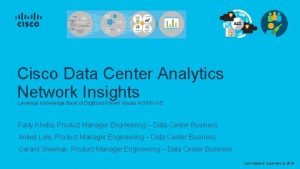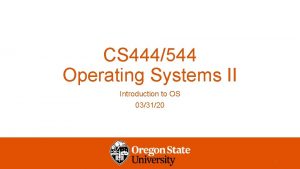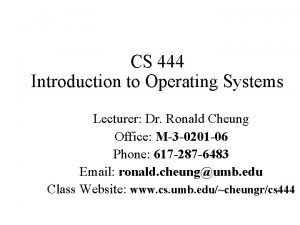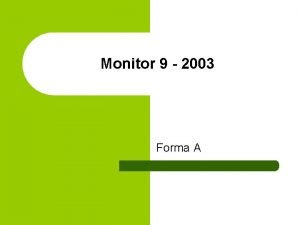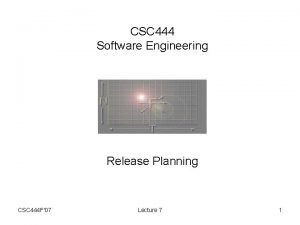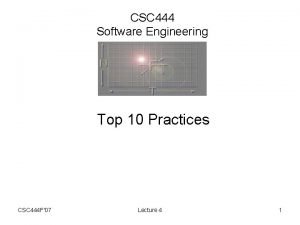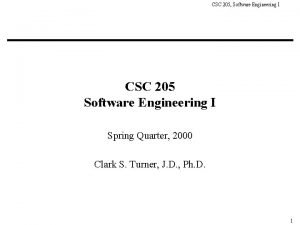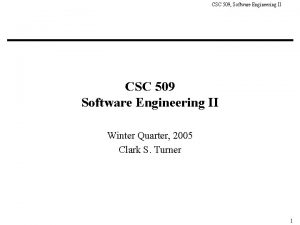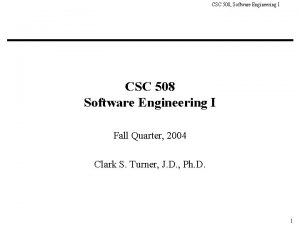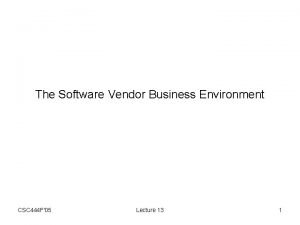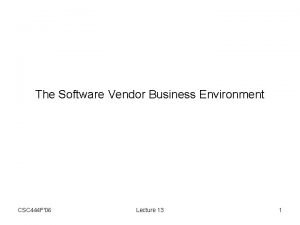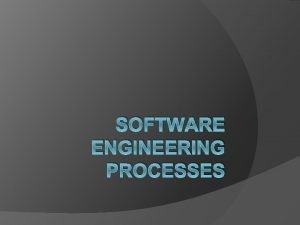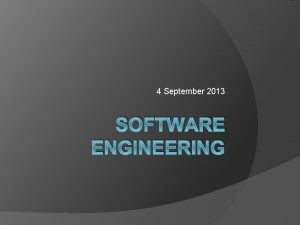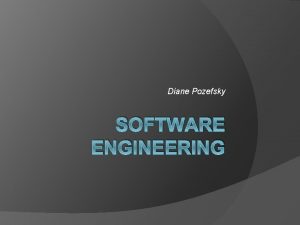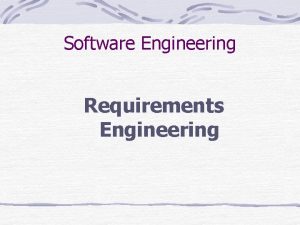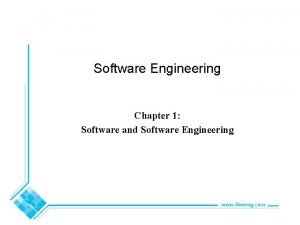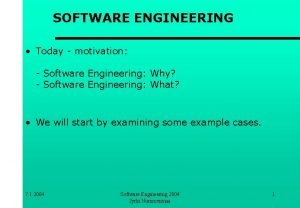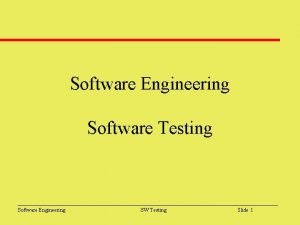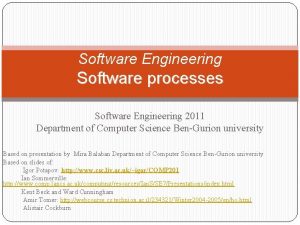CSC 444 Software Engineering Software Releases CSC 444


























- Slides: 26

CSC 444 Software Engineering Software Releases CSC 444 F'07 Lecture 3 1

Software Releases • The software vendor lives and dies the endless dance of the “release cycle” CSC 444 F'07 Lecture 3 2

A Release Lifecycle CSC 444 F'07 Lecture 3 3

A Simple Release Plan Dates: Coding phase: Jul. 1—Oct. 1 Beta availability: Nov. 1 General availability: Dec. 1 Capacity: CSC 444 F'07 Fred Lorna … Bill total days available 31 ecd 33 ecd … 21 ecd 317 ecd Requirement: AR report Dialog re-design … Thread support total days required 14 ecd 22 ecd … 87 ecd 317 ecd Status: 317 effective coder-days 0 effective coder days Capacity: Requirement: Delta: Lecture 3 4

Non-Coding Time and Resource • I explicitly plan coding only. – Other • types of resources: – Testers, documenters, managers • phases: – Specification, testing – these are sized relative to the coding phase and the coding resource • Why? – Debugged code is the ultimate target • Can’t be 90% done on that and still ship intended feature set – How much time to devote to documentation? – How much time to devote to testing? – When is enough, enough? • How? – – – Establish ratios Measure what works for ratios for a given product Adjust next time around Converges rapidly Initial guess is usually pretty good CSC 444 F'07 Lecture 3 5

Resource Ratios • Typical ratios I have used • Adjust to taste • Assumes availability throughout the (overlapping) release cycle. CSC 444 F'07 Lecture 3 6

Phase Length Ratios • • Typical ratios I have used Adjust to taste CSC 444 F'07 Lecture 3 7

Release Overlap • Overlapping release cycles smoothes resource utilization CSC 444 F'07 Lecture 3 8

Shipping The Release • • After dcut, proactive management is gone. Can only watch defect arrivals and hope for the best. – If your ratios are off: forgetaboutit, CSC 444 F'07 Lecture 3 9

Release Concepts & Terminology CSC 444 F'07 Lecture 3 10

Cost of Feature Releases • Considerable overhead associated with a feature release: – – – – • System testing Marketing collateral Launch events Customer/partner briefings New training courses and materials New training internally New CD’s to burn. . . Largest cost of them all – Increased maintenance burden from supporting an extra release in the field • • • Reproduce bug in each codeline Decide what/when to fix Re-test Re-release Maintenance releases are much less costly – Regression tests will do it CSC 444 F'07 Lecture 3 11

Supporting Simultaneous Releases • Generally must support at least 2 feature release maintenance streams. • Usually must support 3. • MUST try to hold the line at 3. • Else all the maintenance will erode the company’s ability to respond in a timely fashion to changing market conditions. • Opportunity cost of developers – A trained developer is scarce resource – New features or maintenance – Opportunity cost of maintenance is the revenue the feature they might have coded could have brought in. CSC 444 F'07 Lecture 3 12

maintenance R 1 shipping R 1. 0 private big new feature X retired shipping R 1. 1 maintenance R 2 shipping R 2. 0 shipping R 2. 1 maintenance R 3 shipping R 3. 0 shipping R 2. 2 shipping R 1. 1 R 2. 2. a ongoing CSC 444 F'07 active Lecture 3 13

Time Between Releases • Feature releases are costly: – Therefore increase the time between feature releases. • But, customers want more features – Therefore decrease the time between feature releases • But, they also want stability in their own IT environment – Therefore increase the time between feature releases. – Sometimes customers get very sticky on old releases – Need to make the new release compelling to end-users • What if one customer or prospect wants a new feature? – New feature release? – Probably not • What if the market condition changes rapidly? – Cut short current release to rush it out? – Go back to last release, extend it, and put that out? – Costly: because of short release cycle will need to support >3 releases in the field. CSC 444 F'07 Lecture 3 14

Pushing Back • A successful development manager will need to distinguish between people asking for things that can be pushed off, and truly urgent things. – Everything is presented as the latter • Track the request back to its source personally. – Will learn the true nature of thee request. – Can deal with 80% of “urgent” requests in this manner CSC 444 F'07 Lecture 3 15

Features in Maintenance Releases • Tried pushing back • Cannot justify a new feature release • Customer/prospect still wants/needs features earlier than the next scheduled feature release • What now? • Slip new features into a maintenance release. • In theory, maintenance releases should change no externally visible program behavior (other than to correct it if faulty). • What the heck, do it anyways. • Does not have the cost of a new feature release. • Why not? CSC 444 F'07 Lecture 3 16

Costs of Features in Maintenance Releases • BASIC RULE: – Cannot introduce new code without introducing new defects • Two reasons for introducing new code: – Fix a defect – Code a feature • If only doing defect corrections: – Fix 2 add 1: the trend is good: -1 – Will eventually get them all (asymptotically) – Converging quality • If also doing new features: – Fix 2 add 1, add a new feature, add 4: the trend is poor: +3 – Diverging quality CSC 444 F'07 Lecture 3 17

Negative Leveraging • The new feature is only useful to one customer. • The defects introduced as a result can negatively impact every customer. • Because touching code risks breaking ANYTHING, ANYWHERE • Customers get irate if a “maintenance release” breaks previously working functionality – Danger even when just fixing defects – Gets much worse if adding features CSC 444 F'07 Lecture 3 18

Release Proliferation • If software quality is poor in general, customers will be slow to upgrade to a release they consider will be more buggy. – Can lead to supporting many releases in the field. • EVEN WORSE: If customers come to fear maintenance releases, they may be reluctant to leave a maintenance release. – They may insist that you fix any issues as patches to their maintenance release – This is catastrophic release proliferation, whereby every point releases turns into a maintenance stream of its own. . . CSC 444 F'07 Lecture 3 19

Does this apply to Web App dev? • • • Absolutely, yes. Seems to be easier to deploy web apps than installed apps. Largely illusory – Installed apps can have “update from web” feature, so is just as convenient – With web app you own all the data, so have to take extra time to not only write the software to migrate the data, but also test the deployment. • Must still test the whole app, which is the largest part of the overhead of a release. • All the other considerations also apply. • Management asks me regularly “is this something that we can do between releases? ” – My answer is almost always “no” – Of course you can technically, but my answer comes from a deeper understanding of the issue where the correct answer for a software professional is “no” because of the loss of productivity and danger of defects escaping into the field. CSC 444 F'07 Lecture 3 20

Mitigating the Consequences • If absolutely forced to, then: • Have a very good regression testing environment • Segregate functionality using run-time configuration switches – Code review to ensure when off, no new code touches the system CSC 444 F'07 Lecture 3 21

Versions • As distinguished from “releases”. • Different variants of the same software – Differ in small ways Must Support: • stream of maintenance releases for each version • each feature release will continue to ship that version • ideally at the same time Version reasons: Hard to Undo the decision to support a new version: • some customer now relies on it CSC 444 F'07 Lecture 3 • multiple hardware platforms • multiple os’s • multiple databases • multiple app frameworks • multiple partner software • security • functional tiers • demoware • translations 22

Cost of Versions • Surprisingly costly to support many versions – Not the development cost: relatively cheap – just another feature – Ongoing maintenance costs • Technical means: – different code (linked differently or #ifdef’d) – run-time switches (e. g. , dynamically detect version of Windows and change API calls appropriately). – different dev platform and tools – binary-compatible: different test environments • In any case: – testers must test all supported versions – coders must bear in mind they are supporting multiple versions – must track down bugs in each version and fix CSC 444 F'07 Lecture 3 23

Version Proliferation • Software company will support many versions in hopes sales will increase – each version opens up a new market segment • Danger: too hastily commit to supporting too many versions • Be aware of costs and push-back • If in the business of supporting many versions: – architect the software well to support it – construct a superb multi-platform automated build/test environment CSC 444 F'07 Lecture 3 24

Customized Software • A different variant of the software for important customers – Static methods: require a distinct executable – Dynamic methods: same executable • run-time switches • alternate dll’s • If customization required on feature release boundary – evaluate if feature’s dev opportunity costs are worth the revenue • If customization required sooner – either: • carefully insert changes into the point release stream • #ifdef all code and build a unique executable for the customer – Can we merge the changes into the next feature release? – Nothing very palatable here • Better to build in enough configurability that customers do not require customizations – gui-based configuration – scripting-based configuration CSC 444 F'07 Lecture 3 25

User Extension API • Allows customers to implement their own features into the software • Danger: – must support the API forever more – even if one already exists internally: • • • clean it up identify public versus private APIs document it train customers on it hire programmers to provide help desk support on it – support becomes “debug the customer’s code” • maintain it unchanged – do not inadvertently change behavior • market it and sell it • consult on it – write it once – support it forever? » paid/unpaid? CSC 444 F'07 Lecture 3 26
 Cellular respiration releases
Cellular respiration releases Cellular respiration releases
Cellular respiration releases Network insights cisco
Network insights cisco Which structure releases glucagon
Which structure releases glucagon The yucca plant releases a strong scent at night
The yucca plant releases a strong scent at night The yucca plant releases a strong scent at night
The yucca plant releases a strong scent at night Computer based system engineering
Computer based system engineering Forward engineering in software engineering
Forward engineering in software engineering Software maintenance process models ppt
Software maintenance process models ppt Who invented software engineering
Who invented software engineering Metrics computer science
Metrics computer science Example of software crisis
Example of software crisis Software measurement and metrics in software engineering
Software measurement and metrics in software engineering Real time software design in software engineering
Real time software design in software engineering Software design fundamentals in software engineering
Software design fundamentals in software engineering 444 5 lecke
444 5 lecke Arti 444 555 666 888 33 88
Arti 444 555 666 888 33 88 Cs 444 oregon state
Cs 444 oregon state Cs 444
Cs 444 Introduction to engineering in society
Introduction to engineering in society 550-444
550-444 Ignatius v bell
Ignatius v bell Ciferny sucet cisla 444
Ciferny sucet cisla 444 Lied 444
Lied 444 444
444 Ptt 444
Ptt 444 0 444 fração geratriz
0 444 fração geratriz


